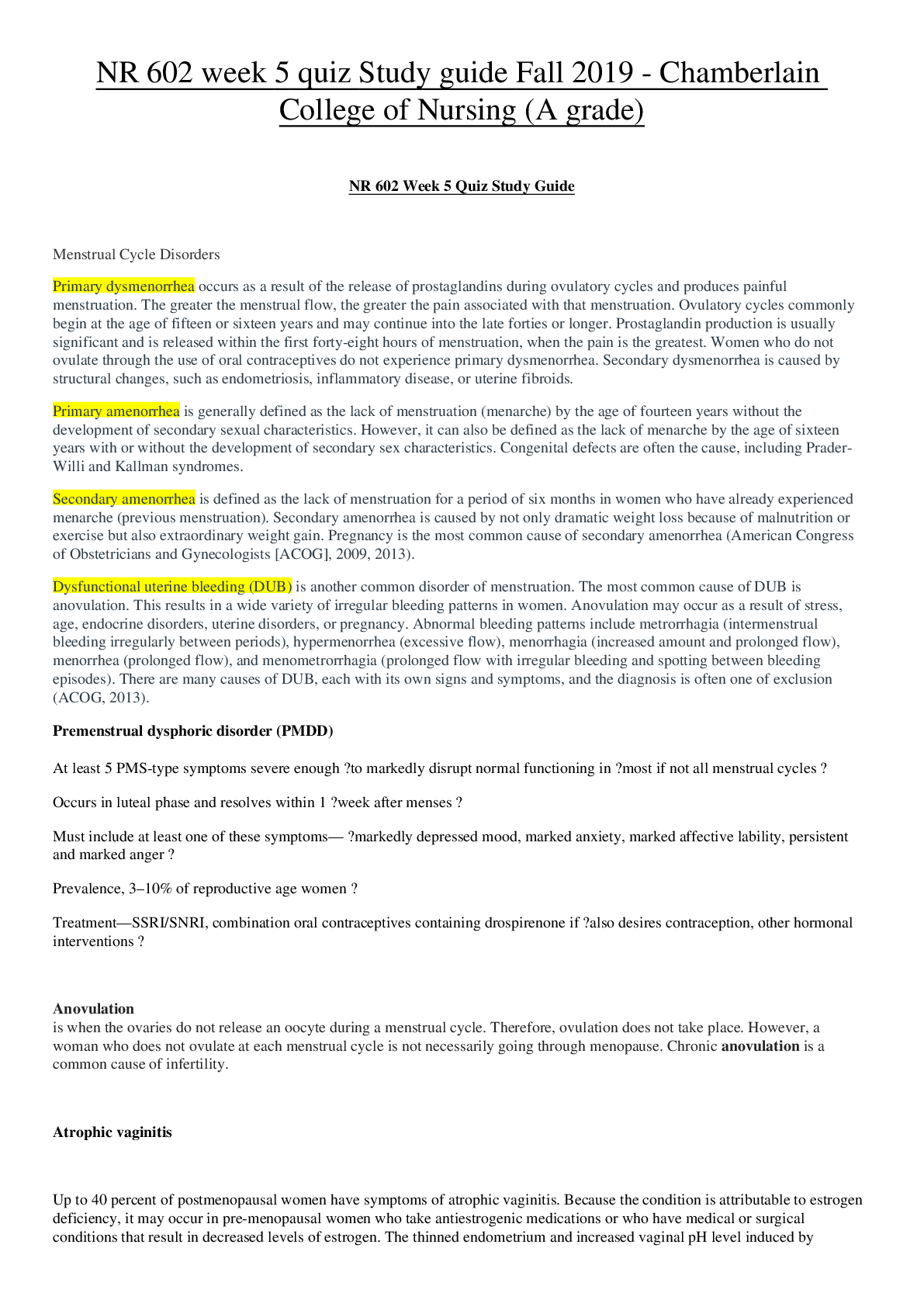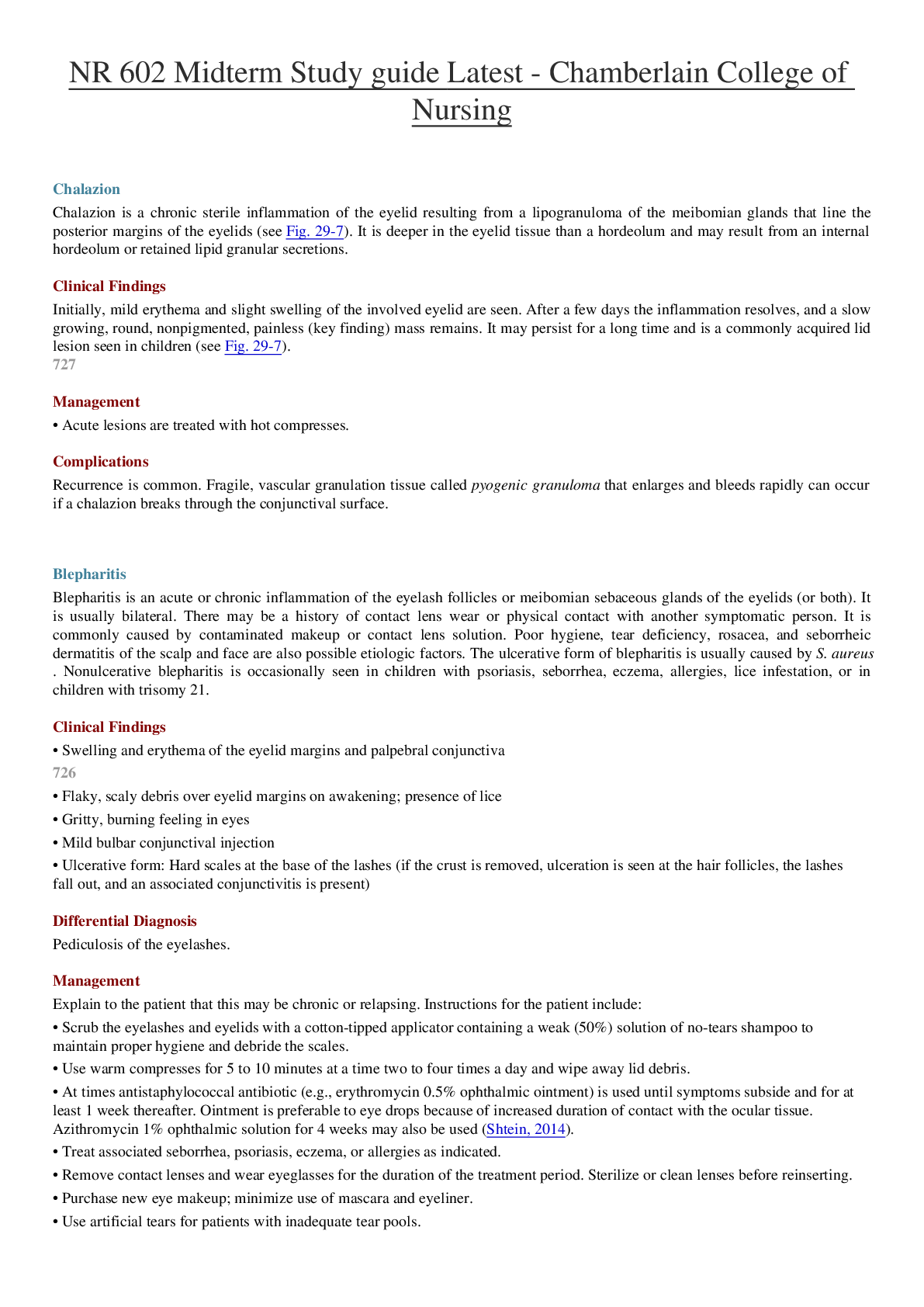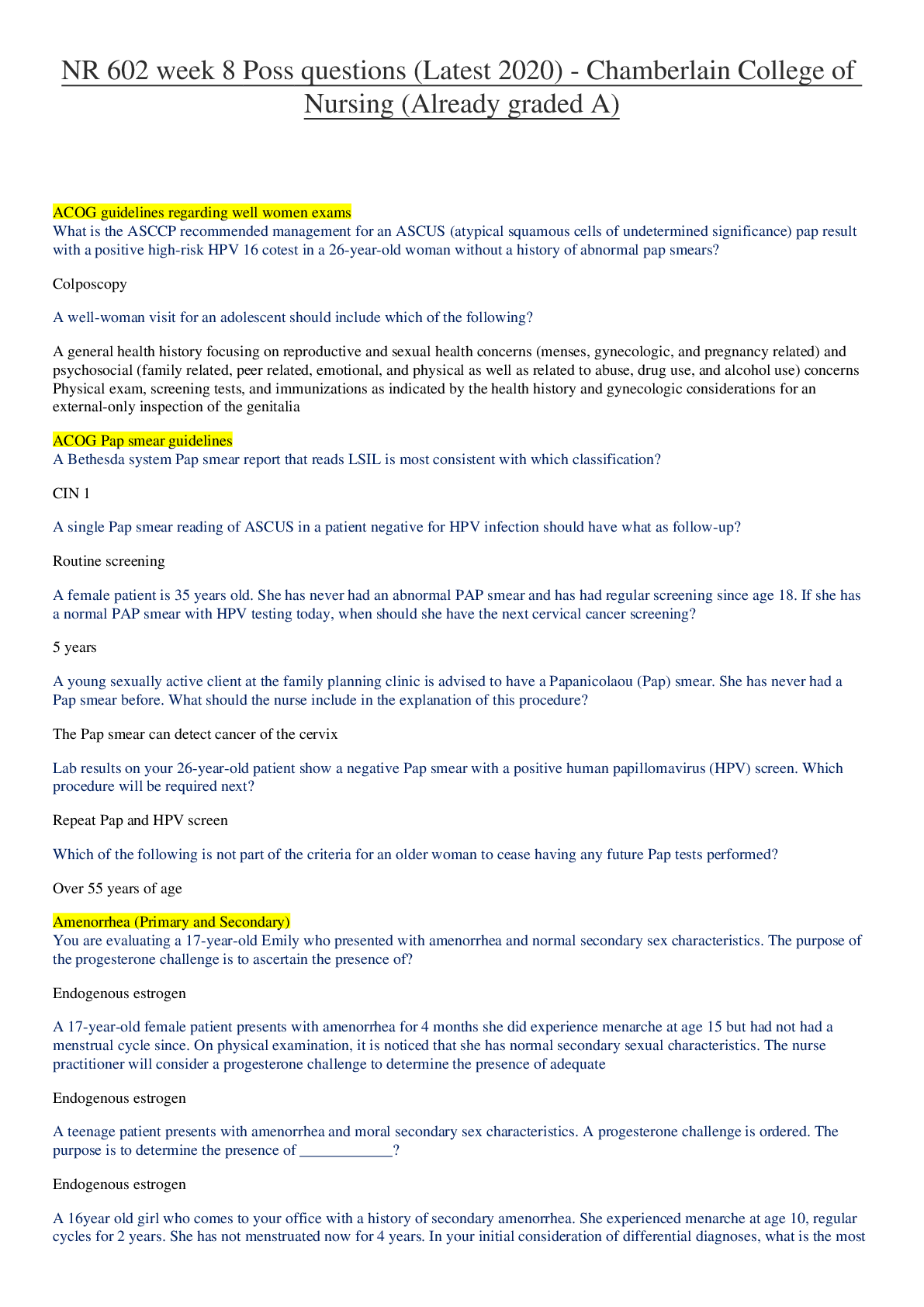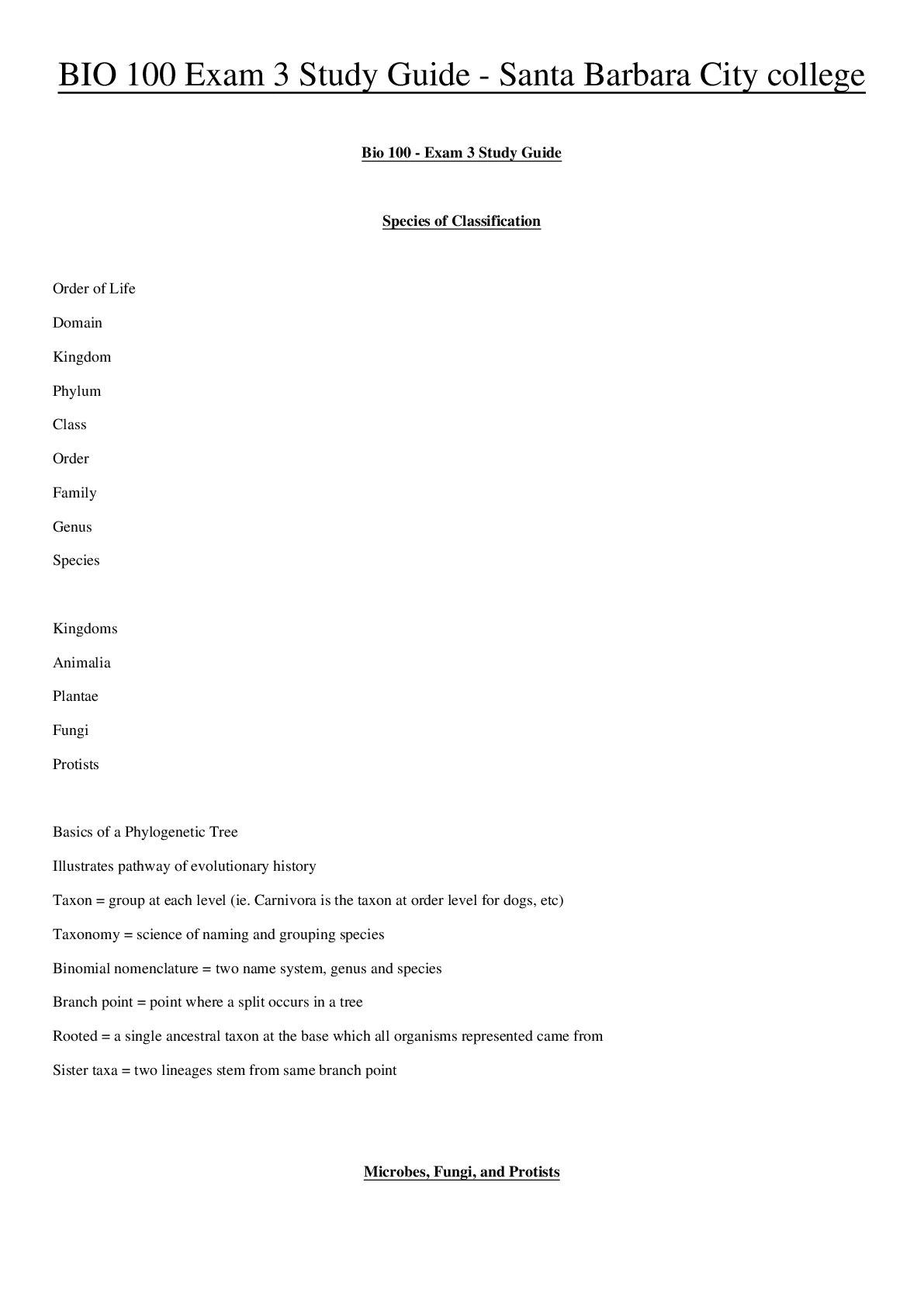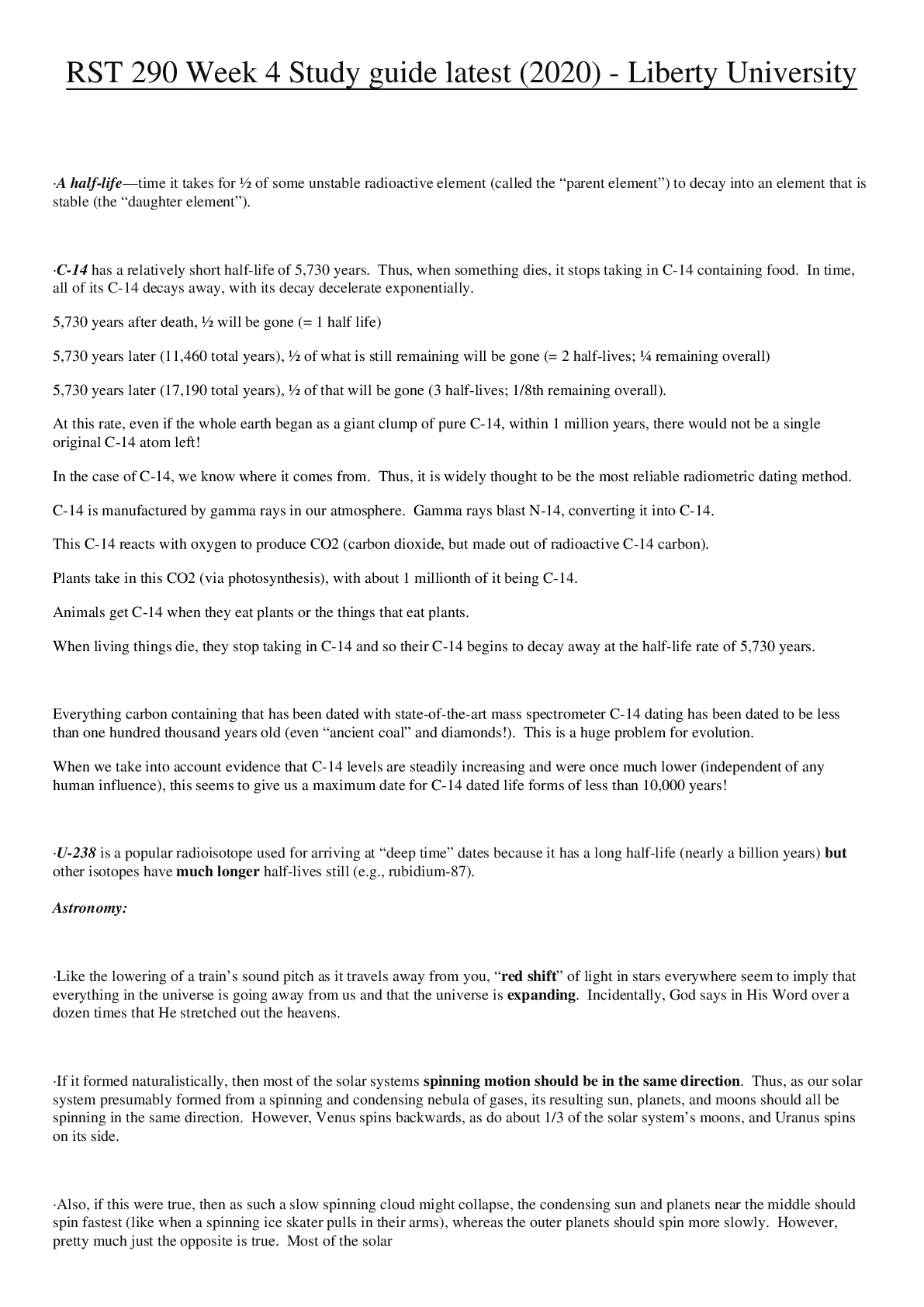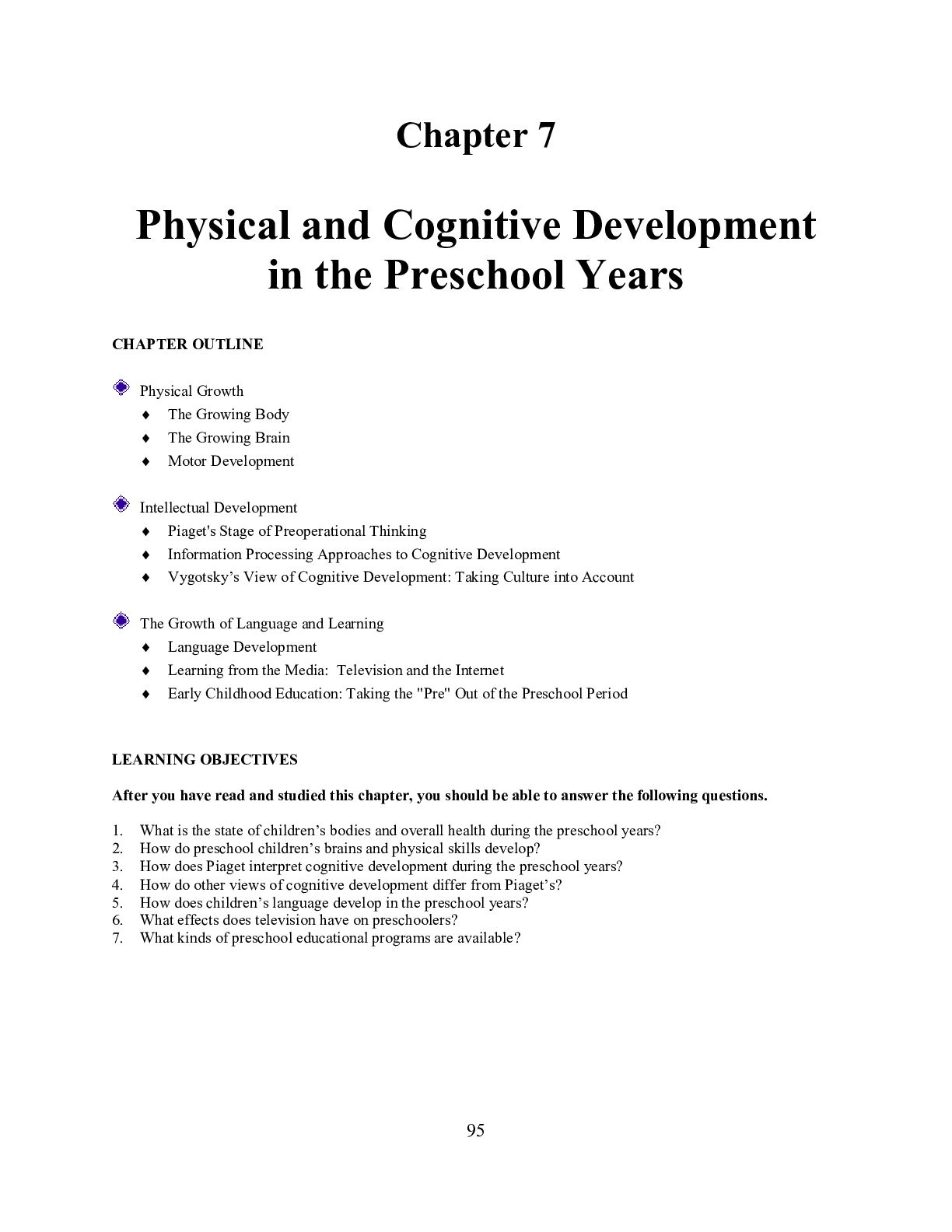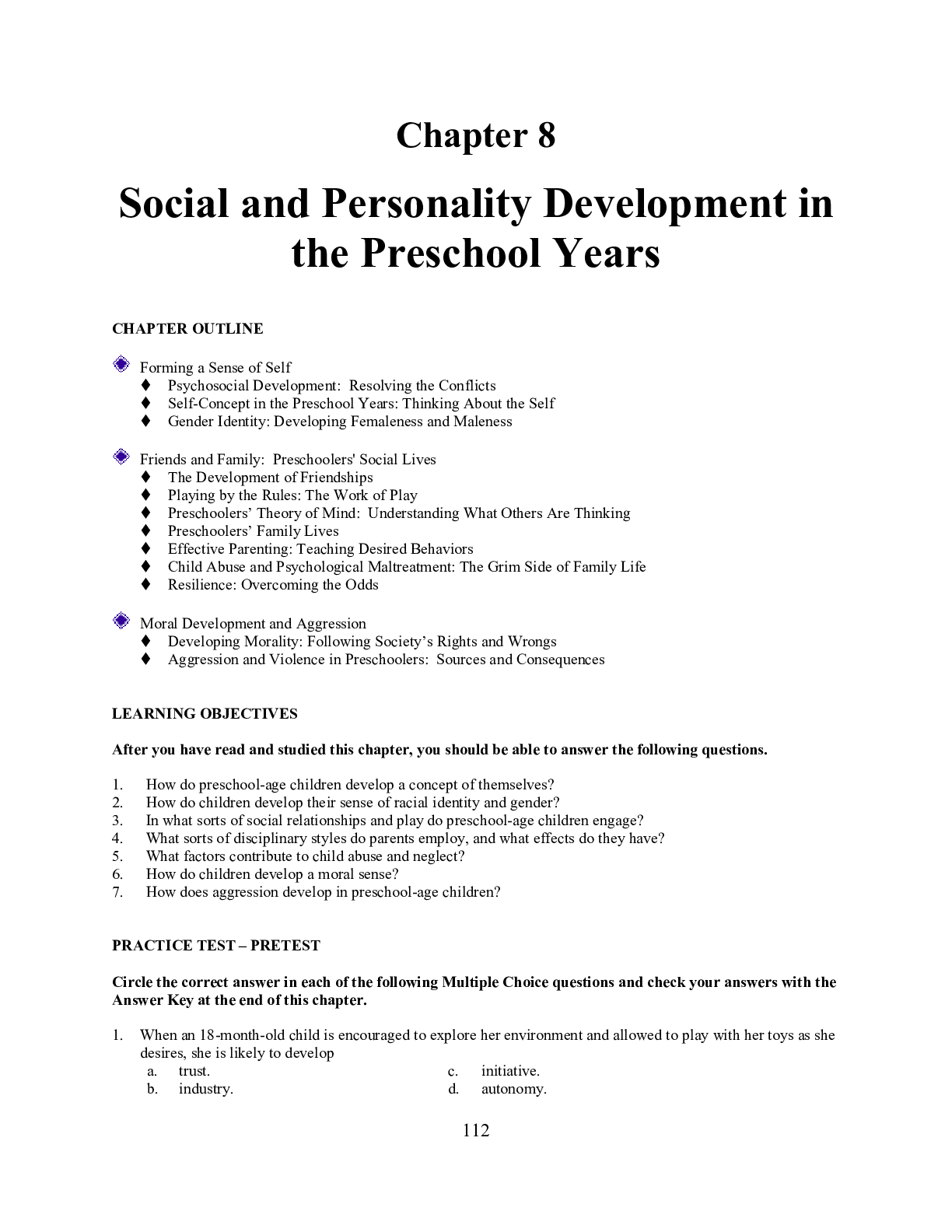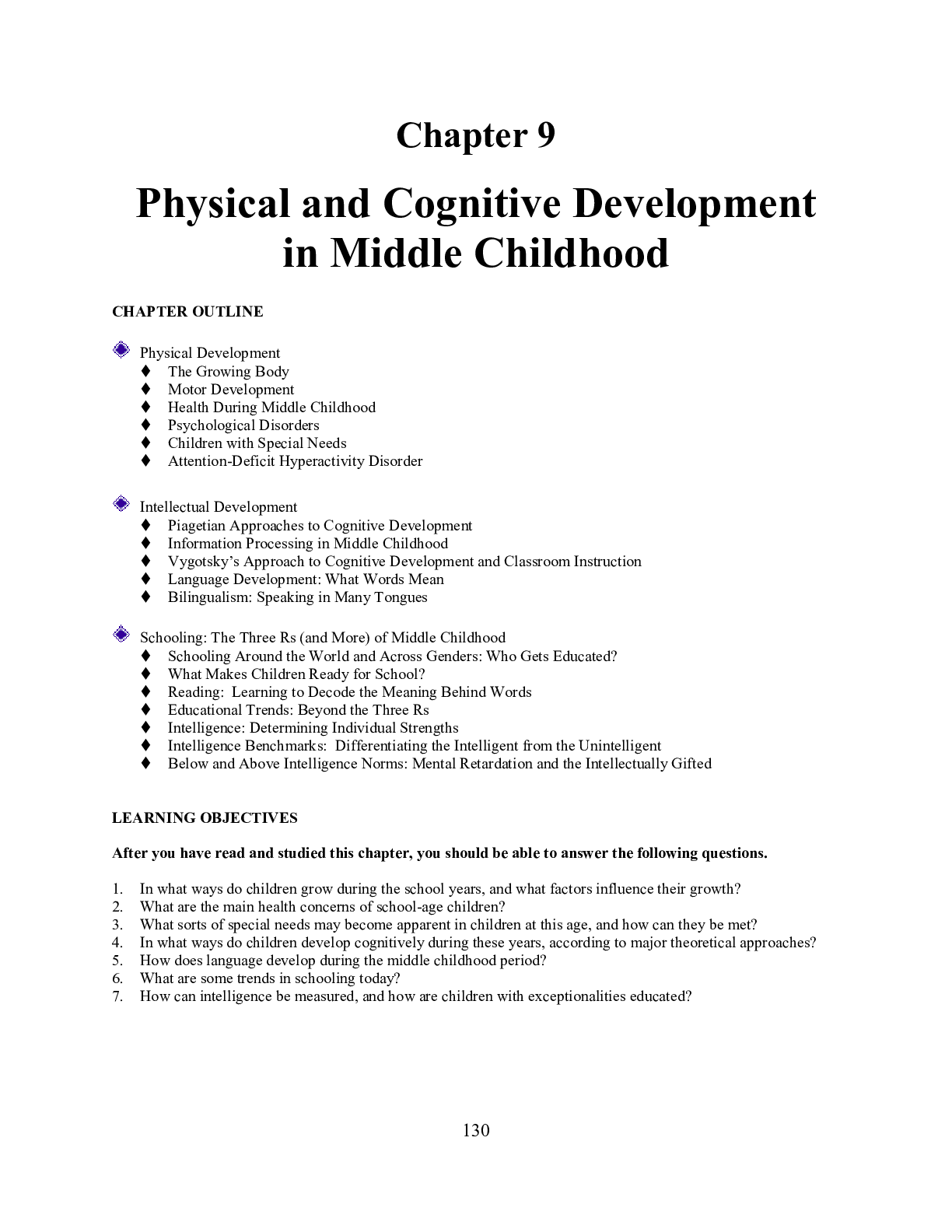Biology > STUDY GUIDE > BIOL 102 Chapter 6 Study guide latest 2020 - Liberty University / BIOL 102 Chapter 6 Study guide lat (All)
BIOL 102 Chapter 6 Study guide latest 2020 - Liberty University / BIOL 102 Chapter 6 Study guide latest 2020
Document Content and Description Below
BIOL 102 Chapter 6 Study guide latest 2020 - Liberty University Chapter 6 Social and Personality Development in Infancy CHAPTER OUTLINE Developing the Roots of Sociability ♦ Emotions in Infanc... y: Do Infants Experience Emotional Highs and Lows? ♦ Social Referencing: Feeling What Others Feel ♦ The Development of Self: Do Infants Know Who They Are? ♦ Theory of Mind: Infants' Perspectives on the Mental Lives of Others–and Themselves Forming Relationships ♦ Attachment: Forming Social Bonds ♦ Producing Attachment: The Roles of the Mother and Father ♦ Infant Interactions: Developing a Working Relationship ♦ Infants' Sociability with Their Peers: Infant – Infant Interaction Differences Among Infants ♦ Personality Development: The Characteristics That Make Infants Unique ♦ Temperament: Stabilities in Infant Behavior ♦ Gender: Boys in Blue, Girls in Pink ♦ Family Life in the 21st Century LEARNING OBJECTIVES After you have read and studied this chapter, you should be able to answer the following questions. 1. Do infants experience emotions? 2. What sort of mental lives do infants have? 3. What is attachment in infancy and how does it affect a person’s future social competence? 4. What roles do other people play in infants’ social development? 5. What individual differences distinguish one infant from another? 6. How does nonparental child care impact infants?81 PRACTICE TEST – PRETEST Circle the correct answer for each of the following multiple choice questions and check your answers with the Answer Key at the end of this chapter. 1. When a 3-month-old infant smiles as her aunt plays with her, the response is called a(n) a. social smile. c. undifferentiated smile. b. reciprocal smile. d. mutually interactive smile. 2. Becky, who is 18 months old, and her older brother are on a sled being pulled by their father. As the sled takes off very quickly, Becky looks at her older brother and notices that he is smiling and really enjoying the ride. On seeing this, Becky smiles too. Becky's reliance on her brother to see how he reacts is called a. synchrony. c. social referencing. b. attachment. d. mutual regulation. 3. At what age do infants and their social partners have roughly equal mutual influence on each other’s behavior? a. 6 months c. 12 months b. 9 months d. 18 months 4. Laura shared her toy with Wes because his toy broke. Laura has reached the age when she is beginning to demonstrate a. trust. c. sympathy. b. empathy. d. self-awareness. 5. Harlow experimented with infant monkeys to study a. empathy. c. temperament. b. attachment. d. social referencing. 6. In the strange situation test, infants' behaviors are used to a. measure reinforcement. c. measure orienting behaviors. b. classify parenting styles. d. classify children's attachment. 7. What traits do mothers of securely attached children appear to exhibit? a. a strong sense of discipline and order b. strong relationships with their husbands c. sensitivity to their infants' needs and desires d. a good understanding of child development patterns 8. How do mothers and fathers play differently with their infants? a. Fathers’ play is more physical. b. Fathers’ play is more conventional. c. Mothers’ play is more spontaneous. d. Mothers’ play is more unconventional. 9. Social referencing is a. smiling in response to other individuals. b. knowledge of one’s self. c. search for information to explain uncertain circumstances. d. knowledge and beliefs about how the mind works and affects behavior. 10. When a caregiver responds promptly to an infant's needs, for example, feeds him when he is hungry and holds him when he cries, Erikson believed that the child develops a. trust. c. initiative. b. intimacy. d. generativity.82 11. Research by Thomas and Chess has classified what percent of infants as “slow-to-warm”? a. 15% c. 35% b. 25% d. 45% 12. What dimension of temperament refers to the degree to which environmental stimuli alter behavior? a. adaptability c. differentiation b. distractibility d. threshold of stimulation 13. Stranger anxiety is common after the age of a. 3 months. c. 18 months. b. 6 months. d. 24 months. 14. With respect to infant emotions, most developmental researchers believe that a. infants experience the same emotions as adults do. b. facial expressions in infants are not accompanied by emotions. c. infant nonverbal expressions reflect emotions. d. positive emotions are expressed more frequently than negative emotions. 15. Enrico is 8 months old and experiences stranger anxiety. He will exhibit more stranger anxiety if a. the stranger is male rather than female. b. the stranger is a child rather than an adult. c. he had a lot of experience with strangers. d. he has experience with siblings. 16. Babies begin to smile reliably by what age? a. 1 to 2 weeks c. 7 months b. 6 to 9 weeks d. 9 months 17. Whose theory explored imprints as a way to examine human attachment styles? a. Harlow c. Bowlby b. Lorenz d. Freud 18. What percent of 1-year-olds are classified as having ambivalent attachment? a. 66% c. 12% b. 20% d. 10% 19. Testing in the Strange Situation reveals that infants from Germany tend to be a. disorganized. c. avoidant. b. secure. d. ambivalent. 20. Patterns of arousal and emotionality that are consistent and enduring characteristics of an individual are a. temperament. c. traits. b. personality. d. socialized. KEY NAMES Match the following names with the most accurate descriptive terms and check your answers with the Answer Key at the end of the chapter. 1. ___ Mary Ainsworth a. contact comfort 2. ___ John Bowlby b. MAX 3. ___ Buss and Plomin c. “safety and security - - - - - - - - - - T Circle the correct answer for each of the following multiple choice questions and check your answers with the Answer Key at the end of this chapter. 1. When Rachel approached the hot stove, her mother showed fear and yelled "don't touch that.” Rachel was able to interpret her mother's vocal and facial expressions and did not touch the stove. This illustrates Rachel's ability for a. social referencing. c. nonverbal decoding. b. nonverbal encoding. d. reciprocal socialization. 2. When is a child over the age of 9 months most likely to pay attention to another person's facial expression in determining how to react to the situation? a. when a situation is ambiguous b. when a situation is unambiguous c. in situations involving the opposite sex d. when self-awareness is fully developed 3. An infant’s ability to show an emotional response that corresponds to the feelings of another person is a. deception. c. empathy. b. temperament. d. gender differentiation. 4. The positive emotional bond that develops between a child and a particular individual is called a. empathy. c. temperament. b. attachment. d. social referencing. 5. Which of the following statements is true regarding culture and attachment? a. Western cultures show the best attachment in the Strange Situation. b. Eastern cultures show the best attachment in the Strange Situation. c. Both Eastern and Western cultures show adequate attachment within the Strange Situation. d. The Strange Situation may be insufficient to describe cultural differences in attachment. 6. A mother drops her daughter off at child care. The child is not upset and begins to explore the center while interacting with other people. Mary Ainsworth would classify the child's attachment with her mother as a. secure. c. avoidant. b. disoriented. d. ambivalent. 7. What proportion of infants form their first primary relationships with more than one individual? a. two-thirds c. one-quarter b. one-half d. one-third 8. Infants and parents learn to communicate emotional states to one another and to respond appropriately to that communication. This is called a. attachment. c. mutual regulation. b. social referencing. d. mutual generalization. 9. The lasting characteristics that differentiate one person from another make up a person’s a. identity. c. personality. b. character. d. differentiated self. 10. If an infant develops normally during the first stage of psychosocial development, she experiences a sense of a. joy. c. identity. b. hope. d. autonomy.91 11. Which of the following is NOT a dimension of temperament? a. adaptability c. differentiation b. activity level d. threshold of responsiveness 12. Harlow’s experiment with the infant monkey’s choice of cuddling showed that a. monkeys preferred the warm, soft “mother” over the wire “monkey.” b. monkeys preferred the wire “monkey” over the warm, soft “mother.” c. monkeys showed secure attachment no matter which stimulus was present. d. monkeys showed ambivalent attachment no matter which stimulus was present. 13. Which of the following statements about infant emotional expression is accurate? a. Basic facial expressions differ widely among cultures. b. Nonverbal encoding changes frequently over the life span. c. Infants display a narrowly focused range of emotions. d. The degree of emotional expressivity varies among infants. 14. Who proposed the theory of minds? a. Izard c. Bowlby b. Harlow d. Flavell 15. Separation anxiety peaks around a. 7 months. c. 12 months. b. 9 months. d. 14 months. 16. A child’s knowledge and beliefs about the mental world is a. a theory of mind. c. self-awareness. b. empathy. d. a differential emotion theory. 17. Kathy is not distressed when her mother leaves and stays away from her when she returns. Kathy would be classified as a. secure. c. ambivalent. b. avoidant. d. disorganized. 18. Which attachment style is characterized by low seeking proximity with caregiver, low maintaining contact with caregiver, high avoiding proximity with caregiver, and low resisting contact with caregiver? a. secure c. ambivalent b. avoidant d. disorganized 19. The process in which infants’ behaviors invite further response from parents, which in turn brings about further responses from infants, is a. mutual responsiveness. c. accommodation. b. assimilation. d. reciprocal socialization. 20. What percent of children between 4 months and 3 years of age spend time in nonparental child care? a. 50% c. 75% b. 66% d. 80% LEARNING OBJECTIVES REVISITED 1. Do infants experience emotions? • Infants display a variety of facial expressions, which are similar across cultures and appear to reflect basic emotional states. • By the end of the first year, infants often develop both stranger anxiety, wariness around an unknown person, and separation anxiety, distress displayed when a customary care provider departs.92 • Early in life, infants develop the capability of nonverbal decoding: determining the emotional states of others based on their facial and vocal expressions. • Through social referencing, infants from the age of 8 or 9 months use the expressions of others to clarify ambiguous situations and learn appropriate reactions to them. 2. What sort of mental lives do infants have? • Infants begin to develop self-awareness at about the age of 12 months. • They also begin to develop a theory of mind at this time: knowledge and beliefs about how they and others think. 3. What is attachment in infancy and how does it affect a person’s future social competence? • Attachment, a strong, positive emotional bond that forms between an infant and one or more significant persons, is a crucial factor in enabling individuals to develop social relationships. • Infants display one of four major attachment patterns: securely attached, avoidant, ambivalent, and disorganized-disoriented. Research suggests an association between an infant’s attachment pattern and his or her social and emotional competence as an adult. 4. What roles do other people play in infants’ social development? • Mothers’ interactions with their babies are particularly important for social development. Mothers who respond effectively to their babies’ social overtures appear to contribute to the babies’ ability to become securely attached. • Through a process of reciprocal socialization, infants and caregivers interact and affect one another’s behavior, which strengthens their mutual relationship. • From an early age, infants engage in rudimentary forms of social interaction with other children, and their level of sociability rises as they age. 5. What individual differences distinguish one infant from another? • The origins of personality, the sum total of the enduring characteristics that differentiate one individual from another, arise during infancy. • Temperament encompasses enduring levels of arousal and emotionality that are characteristic of an individual. Temperamental differences underlie the broad classification of infants into easy, difficult, and slow to-warm categories. • As infants age, gender differences become more pronounced, mostly due to environmental influences. Differences are accentuated by parental expectations and behavior. 6. How does nonparental child care impact infants? • Child care, a societal response to the changing nature of the family, can be beneficial to the social development of children, fostering social interaction and cooperation, if it is of high quality. [Show More]
Last updated: 2 years ago
Preview 1 out of 15 pages
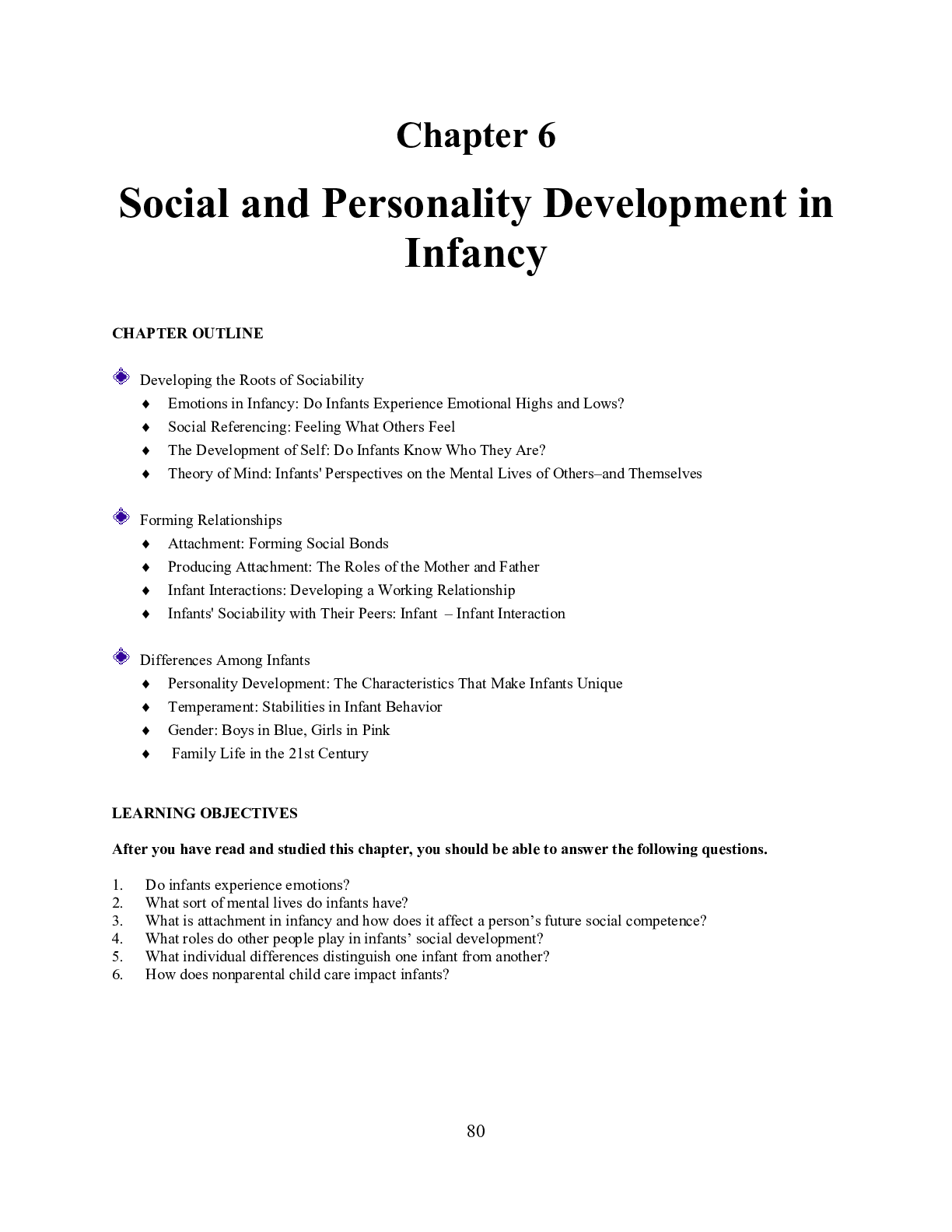
Buy this document to get the full access instantly
Instant Download Access after purchase
Buy NowInstant download
We Accept:

Reviews( 0 )
$11.50
Can't find what you want? Try our AI powered Search
Document information
Connected school, study & course
About the document
Uploaded On
May 28, 2020
Number of pages
15
Written in
Additional information
This document has been written for:
Uploaded
May 28, 2020
Downloads
0
Views
131







